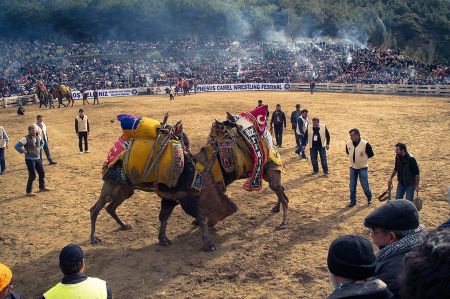The historically legendary Selçuk camel fight
- Written by Portal Editor
The centuries-old tradition of camel fighting in Western Anatolia has its origins in the time when nomadic peoples led their caravans thousands of kilometres across the country on their way from the Orient to the West.
Today the tradition is considered to be in decline because only the rich can afford to keep, feed and train camels exclusively for wrestling. Some time ago the phenomenon was widespread throughout the Anatolian region of Turkey, but today it is mainly limited to the Aegean and Mediterranean coasts. Still, the millennial tradition can be seen in a number of championships - a so-called Camel Wrestling League begins in mid-to-late December and continues through March.
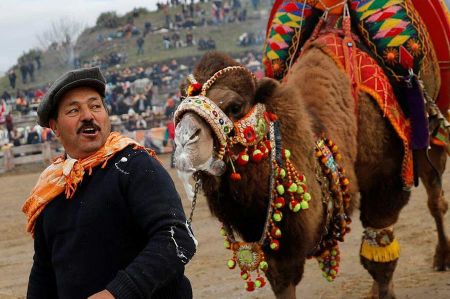 Even today, camel fighting, also known as “camel wrestling” in modern German, is one of the most venerable activities for Anatolian men on the Turkish Aegean coast. Between December and March, during the camel rutting season, many places in southwest Turkey revive the ancient tradition. Camel Wrestling Championships is an all-Turkish feature on par with Spanish bullfights and Italian cockfights. While animal rights advocates are against such competitions, they are not violent and are actually based on natural instincts. The matches are held in different locations, but the most famous place to host such fights is Selçuk in Izmir Province. Often gathering an audience of 20,000 people, Selçuk is the place known as Turkey's most attended camel wrestling festival. Other towns and villages can be found primarily in the provinces of Aydın, Çanakkale, Balıkesir, Denizli, Antalya, Konya and others. Some, but not all, of them are marked on the map below.
Even today, camel fighting, also known as “camel wrestling” in modern German, is one of the most venerable activities for Anatolian men on the Turkish Aegean coast. Between December and March, during the camel rutting season, many places in southwest Turkey revive the ancient tradition. Camel Wrestling Championships is an all-Turkish feature on par with Spanish bullfights and Italian cockfights. While animal rights advocates are against such competitions, they are not violent and are actually based on natural instincts. The matches are held in different locations, but the most famous place to host such fights is Selçuk in Izmir Province. Often gathering an audience of 20,000 people, Selçuk is the place known as Turkey's most attended camel wrestling festival. Other towns and villages can be found primarily in the provinces of Aydın, Çanakkale, Balıkesir, Denizli, Antalya, Konya and others. Some, but not all, of them are marked on the map below.
Days before the actual competition, the streets of the picturesque town of Selçuk have been transformed into one vibrant village festival. There is hardly a house from which the Turkish national flag does not fly or which does not have a portrait of Kemal Mustafa Atatürk, the founder of modern Turkey. The bars in the centre of the town are filled to capacity; in front of them, men with orange scarves dance through the night, constantly accompanied by the distinctive sound of drums and the Turkish folkloric oboe (Zurna), played by Roma musicians.
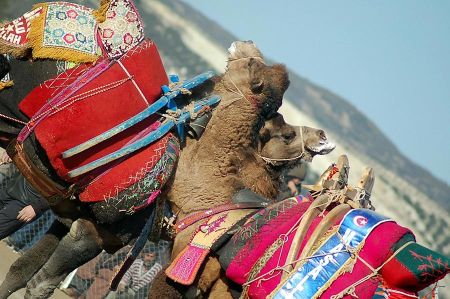 The smell of grilled meat permeates the nighttime backdrop, platters of local delicacies are balanced above the guests' heads, and the raki is refilled almost every second. Camel wrestling has a long tradition in Turkey, but has only been practiced regularly again in Selçuk for just over thirty years. While hundreds of thousands of tourists travel to nearby Ephesus between spring and autumn to explore the ancient ruins of the famous Library of Celsus and the Temple of Hadrian, there are hardly any foreign guests in the region in the winter months. So far, despite the unique cultural event, this has not changed, and so these days Selçuk belongs exclusively to the locals.
The smell of grilled meat permeates the nighttime backdrop, platters of local delicacies are balanced above the guests' heads, and the raki is refilled almost every second. Camel wrestling has a long tradition in Turkey, but has only been practiced regularly again in Selçuk for just over thirty years. While hundreds of thousands of tourists travel to nearby Ephesus between spring and autumn to explore the ancient ruins of the famous Library of Celsus and the Temple of Hadrian, there are hardly any foreign guests in the region in the winter months. So far, despite the unique cultural event, this has not changed, and so these days Selçuk belongs exclusively to the locals.
Today just duels
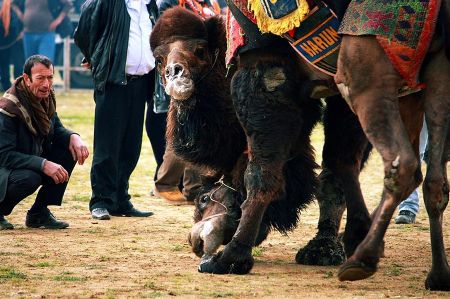 On the day before the actual competition, the beautifully decorated camels are paraded through the centre of Selçuk with considerable pomp. While many of the men wash away the hangover from the previous night's excessive raki consumption with copious amounts of chai or Turkish coffee, curious children with their mothers and grandparents inspect the camels waiting to be awarded prizes by the judge. Whoever wins seems irrelevant to many of the men; the actual event in the ancient arena of Ephesus is still to come. Instead, everyone eats, drinks and dances until late every evening. Hussein, an experienced festival participant, sits at one of the tables in Gökhan's restaurant. He sent his camel Süleyman, named after the important Ottoman ruler, into competition almost a dozen times and, as he emphasizes, always emerged as the winner. “In the past, a camel fought several rounds until it reached the final, but today there are so many participants that there are only duels,” says Hussein, explaining the developments in the competition.
On the day before the actual competition, the beautifully decorated camels are paraded through the centre of Selçuk with considerable pomp. While many of the men wash away the hangover from the previous night's excessive raki consumption with copious amounts of chai or Turkish coffee, curious children with their mothers and grandparents inspect the camels waiting to be awarded prizes by the judge. Whoever wins seems irrelevant to many of the men; the actual event in the ancient arena of Ephesus is still to come. Instead, everyone eats, drinks and dances until late every evening. Hussein, an experienced festival participant, sits at one of the tables in Gökhan's restaurant. He sent his camel Süleyman, named after the important Ottoman ruler, into competition almost a dozen times and, as he emphasizes, always emerged as the winner. “In the past, a camel fought several rounds until it reached the final, but today there are so many participants that there are only duels,” says Hussein, explaining the developments in the competition.
There are now said to be almost 1,200 competition camels, called Tulu, in Turkey. Most of them were specially bred and imported from Iran or Afghanistan for a lot of money.
Surrounded by devoted listeners, Hussein tells adventurous stories of past battles, the intensity of which seems to increase with every glass of raki. Many of the enemy camels had already fled at the sight of Süleyman. The men laugh loudly at the cowardice of the camels in Hussein's anecdote.
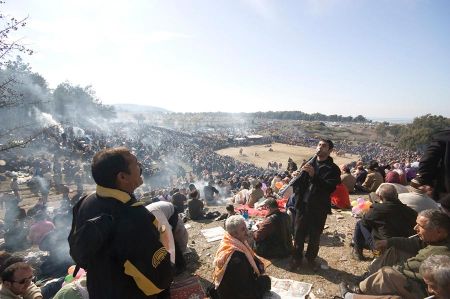 According to the competition rules, a camel can win in three ways: In the first method, the camel drives away its rival with its imposing appearance; in the second method, the losing camel roars as soon as it can no longer counteract the other's strength. In both events, the loser and therefore his owner leave the competition arena to the laughter of the crowd. In most cases, however, the camels try to push each other down or knock them over in order to demonstrate their superiority and the resulting claim to the female. The animals can sometimes become wilder. If one of the camels is pushed down, it tries to bite its rival's hooks to balance the situation. However, this can be dangerous and there is a risk of the animals injuring each other. “In this case, the owner of the losing camel is obliged to throw a rope into the middle and admit defeat in order to avert danger to the animals,” Hussein explains the code of conduct. “The camel is worth more to its owner than your own life,” he adds. He would never allow Süleyman to get hurt.
According to the competition rules, a camel can win in three ways: In the first method, the camel drives away its rival with its imposing appearance; in the second method, the losing camel roars as soon as it can no longer counteract the other's strength. In both events, the loser and therefore his owner leave the competition arena to the laughter of the crowd. In most cases, however, the camels try to push each other down or knock them over in order to demonstrate their superiority and the resulting claim to the female. The animals can sometimes become wilder. If one of the camels is pushed down, it tries to bite its rival's hooks to balance the situation. However, this can be dangerous and there is a risk of the animals injuring each other. “In this case, the owner of the losing camel is obliged to throw a rope into the middle and admit defeat in order to avert danger to the animals,” Hussein explains the code of conduct. “The camel is worth more to its owner than your own life,” he adds. He would never allow Süleyman to get hurt.
Short confrontations
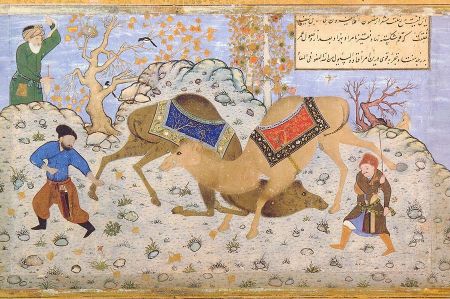 Already in the early hours of the morning, thousands of visitors gather in the arena near Ephesus to secure the best seats for the upcoming competition day. Wooden chairs are set up, picnic blankets are spread, barbecue grills are activated and dozens of raki bottles are placed in position.
Already in the early hours of the morning, thousands of visitors gather in the arena near Ephesus to secure the best seats for the upcoming competition day. Wooden chairs are set up, picnic blankets are spread, barbecue grills are activated and dozens of raki bottles are placed in position.
The first fight begins just after ten in the morning. Two bull camels are led into the arena to thunderous applause from the crowd. The two seem a bit lethargic at first and don't think about courting the female standing nearby. The owners walk in circles with the camels until suddenly the spark of rivalry ignites and the natural rutting behaviour is activated. The animals repeatedly try to push the opponent down with their long necks. The animals are not in danger. Soon one of the camels decides to retreat. The crowd cheers. The even-toed ungulates trot out of the arena together, relatively unimpressed. Let the games begin. Over 60 duels are on the program, each lasting a little less than ten minutes.
After a few hours, the visitors in the arena really get going. The announcer announces the names of new competitors in unison, men dance to the sounds of drums and zurna, camel sausages are fried and sold in sandwiches on every corner. When Hussein and his camel, Süleyman, finally enter the arena, the audience's mood seems to have reached its peak.
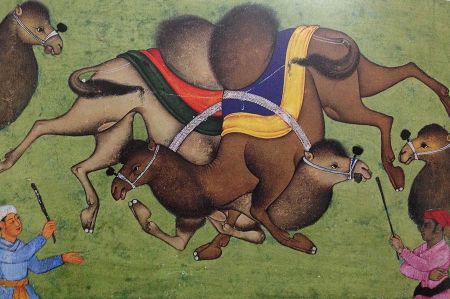 The fight begins. Süleyman routinely looks for his advantage and begins to push the generic camel to the ground. Both animals spray copious amounts of foamy saliva, a behaviour typical of bulls in heat, as they sit back up and reassess the situation. One of the camels alternately seems to have the upper hand, only to then have to submit to the opponent again. Hussein's gaze looks strained. The man knows that none of the animals will escape. It could soon become too strenuous for the camels and then the men would have to make a decision.
The fight begins. Süleyman routinely looks for his advantage and begins to push the generic camel to the ground. Both animals spray copious amounts of foamy saliva, a behaviour typical of bulls in heat, as they sit back up and reassess the situation. One of the camels alternately seems to have the upper hand, only to then have to submit to the opponent again. Hussein's gaze looks strained. The man knows that none of the animals will escape. It could soon become too strenuous for the camels and then the men would have to make a decision.
Once again, the tide seems to be turning, but soon both are on equal terms again, kneel down and begin to bite each other's hooks. The men know that the fight must be ended for the good of the animals before Süleyman and/or his rival seriously injure themselves. Both men throw the ropes. The audience rises from their seats cheering. What a fight! To thunderous applause, the referee finally gave the verdict: “Draw.” Both camels emerged as winners. Hussein and Süleyman leave the arena full of pride. In just a few days they will compete in another competition in southern Turkey. Until then, it's time to take a breather and review the day's fight over a glass of raki.
Please read as well:
